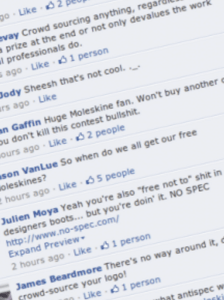Moleskine created a “Molescheme” through failed crowdsourcing effort

In 2011 Moleskine needed to redesign it’s logo for its online platform, Moleskinery. Naturally, the company looked to harness the loyalty of its artistic and design-focused customer base by crowdsourcing the new logo design. Unfortunately, their failed crowdsourcing attempt created unforeseen backlash and public animosity amongst their loyal customer base.
Moleskine is the maker of treasured notebooks for artists, writers, and designers alike that are modeled after those used by greats like Ernest Hemingway and Vincent Van Gogh. The brand has become synonymous with simplicity, nostalgia and design excellence. Over time, a Moleskine notebook becomes an artist’s priceless possession, holding prized sketches, notes, and song lyrics. The company’s customer base is frenetic about the brand, often refusing to purchase other mainstream notebooks.
However, in 2011, Moleskine needed to redesign it’s logo for its online platform, Moleskinery. Naturally, the company looked to harness the loyalty and talent of its artistic and design-focused customer base by crowdsourcing the new logo design. Unfortunately, their failed crowdsourcing attempt created unforeseen backlash and public animosity amongst their loyal customer base.
The failed contest
The bounds of the contest were fairly simple. In late 2011, Moleskin announced their crowdsourcing event to create a new logo for Moleskinery. Anyone was allowed to participate, and the selected winner would receive a 7,000 euro reward. In addition, Moleskine would retain the IP for all submitted design ideas.
The backlash to the event was quick and fierce.
Overall, the crowdsourcing event failed because it turned an otherwise remarkably loyal fan base against the company, for the two basic below reasons:
- Failure to fully think through the implications for the customer base. What Moleskine failed to realize is that crowdsourcing is a touchy subject for designers. Rather than paying designers for their work, Moleskine, in their opinion, was going to receive a plethora of new, creative ideas for free. Through crowdsourcing, Moleskine would ask many people to do the creative work, find the idea they liked best, and only pay that designer. No other designers were rewarded, and all designers lost their IP.
This left the impression that Moleskine was devaluing the designer, which is the exact community that had dogmatically supported the rise of the brand. The choice of crowdsourcing for logo development created a sentiment of betrayal and distrust amongst the fan base.
- Failure to admit wrongdoing. Moleskine’s first response to the outcry on Facebook was defensive and failed to admit that they were wrong. Their response included statements such as “other companies are doing it” and “you are free not to enter” the competition. Only on their second response did the company admit that crowdsourcing may not have been the correct way to engage their community in the logo design process and further apologized for their insensitive first response.
I believe that Moleskine should not have launched a crowdsourcing campaign in this fashion. The company should have recognized that retaining the IP, in particular, would make the campaign feel highly speculative to their community. While I don’t know that I would blindly recommend crowdsourcing to a company like Moleskine in the future, I would recommend that they allow any designer that submits a design not selected as the winner to maintain the IP.
Sources: newkind.com, yannigrowth.com, writerunderground.com




Great post! Super interesting to hear about a crowdsourcing effort gone wrong, as all the cases we have read on it make it seem as if it can do no wrong. It would be helpful for companies to think through implementation guidelines or policies for crowdsourcing as part of their digital marketing or innovation teams prior to launching these types of initiatives!
It’s interesting to note the backlash for this event was so different from the views of the programmers working for TopCoder, for instance. I believe TopCoder retained most of the IP and work done by their programmers to maintain a virtual playbook of all coding solutions, which they then used to attract clients, promising shorter delivery times by building on an already existing repository of coding work. I wonder what the difference is between TopCoder and the loyal fan base of Moleskine. Perhaps it is the greater focus on art and creativity and originality? Would love to hear your thoughts!
I’m also curious to get your opinion on whether or not this entire fiasco could have been avoided if Moleskine had just claimed that all IP would be returned to the designers, or if there were other elements that made this competition undesirable and rage-inducing to the fans.
Thanks!
I agree, great post! Successful crowdsourcing seems to hinge on the crowd’s attitude towards sharing information and ideas; among software engineers, there is a culture of opensource code, which has spawned companies like Github. Among artists and writers, there is more value placed on personal recognition and reward, as well as ownership of intellectual property, as your post highlights. Secondly, the value proposition for the crowd is also a factor – what is in it for people to submit logo design ideas, particularly when only one person can win? If Moleskin crowdsourced ideas for a new style of notebook or limited edition color, they would likely have a more positive reception and higher user engagement as idea creators would benefit from buying the type of notebook they wish existed.